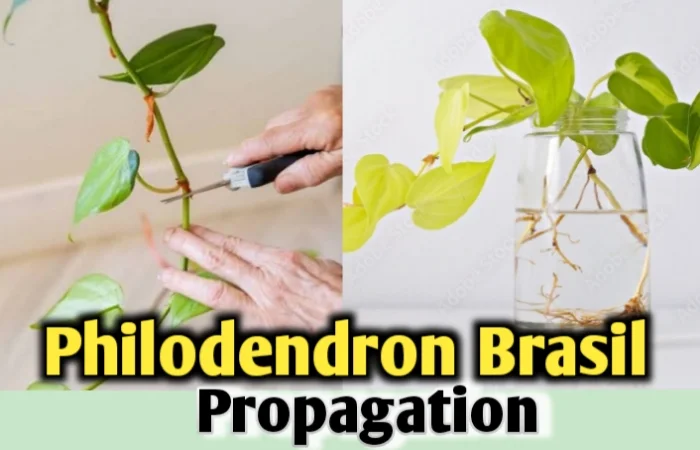Philodendron Bernardopazii- Care, Propagation, Problems & Solution
Do you want to enrich your houseplant collection with the beautiful Philodendron Bernardopazii plant?
Philodendron Bernardopazii is an amazing species that can exhibit an aristocratic look to you. But before having the plant, you may want to check the details about this plant. That’s why the content is in front of you.
Philodendron Bernardopazii plant leaves’ extraordinary look attracts all. It is very easy to maintain and propagate this plant and that’s why you don’t need to worry about regular maintenance processes.
So, why don’t you have some more points about Philodendron Bernardopazii?
Genus Origin
Philodendron, a huge genus, is the second-largest member of the Araceae family.
The Greek word ‘Philo’ means love or endearment. Philodendron Bernardopazii is formerly named “Santa Leopoldina” because of its locale. Later it is named Superbum until the current name is applied.
Philodendron originated from the Jungles of Brazil.
Because of come from tropical areas, they love shady areas. Indirect bright light is the main demand of them.
Philodendron Bernardopazii Overview
Philodendron Bernardopazii is a lovely houseplant that can enhance the beauty of your garden. Some common factors of Philodendron Bernardopazii should be discussed earlier.
| Category | Property |
| Common Name | Philodendron Bernardopazii |
| Scientific Name | Philodendron Bernardopazii |
| Family | Araceae |
| Genus | Philodendron |
| Native to | Brazil |
| Width | 14-18 inch (approx) |
| Height | 2 feet (approx) |
| Foliage | Grown for foliage, Evergreen |
| Light | Indirect Bright Light, Light shade |
| Water | Regular avg. water, Don’t Overwater |
| Soil | Regular Potting Mix |
| Soil pH | 6.9-7.3 |
| Temperature | (70-84) F (21-30) C |
| Maximum cold tolerance | 25 degrees to 30 degrees Fahrenheit |
| Humidity | Medium moisture |
| Fertilizer | Less than regular |
| Propagation Methods | From herbaceous stem cuttingsBy air layering |
| Perfect acquaintances as | House plant |
Philodendron Bernardopazii is an exceptional houseplant having broad glossy leaves. This Brazil-originated houseplant can easily refresh your mind if you provide proper necessary things like sunlight, humidity, fertilizers etc. You can also multiply its number by vegetative propagation easily.
Is Philodendron Bernardopazii Rare?
Philodendron Bernardopazii is a rare collection among the Philodendron family. You may not get much information about it. It may not be found in all the nurseries too. That’s why it is called a rare beauty.
This may be rare in the collection but there is no compromise in the expression of beauty. So having this species will undoubtedly enhance the entire beauty of your garden or houseplant.
Bernadopazii Morphology
Plant Type
Philodendron Bernardopazii is a tropical plant that loves to grow in a moderate region. This is one type of mesophytic plant that can be easily cultivable in your garden.
It is a kind of herbaceous plant when it is smaller in size. It may also be considered in the list of shrubs because of its elongated but not woody stem.
Plant height may be up to 12 feet. But the average range is 6 to 12 feet. It is such a kind of plant which needs a moderate amount of sunlight to complete its whole photosynthetic system. The light-dependent phase of photosynthesis is more important in its life cycle.
Its vascular bundle system means the overall procedure of food, nutrients and the water-conducting process is well developed.
Root system
The root system of philodendron Bernardopazii is fibrous or adventitious.
At the very first stage of the root system, a taproot or deep root is formed. But with time, this deep root is denatured and an adventitious or shallow root system is developed which can easily cope up as a pot plant.
The fibrous root system helps them to collect water from every part of the pot or garden soil. This is also helpful for vegetative propagation.
Leaves
Philodendron Bernadopazii has uniquely shaped large leaves. They are highly sought after for their exceptional beauty of foliage patterns.
Leaves are elongated, glossy with contrasting white veins that are also beautiful underneath with red veins. Their leaf base is strongly attached to the stem which gives them support for better growth.
Leaf lamina or leaf blades’ elongated shape helps for a better photosynthesis process. Leaf lamina is called the surface of the leaf which is exposed to the sunlight and needed for photosynthesis.
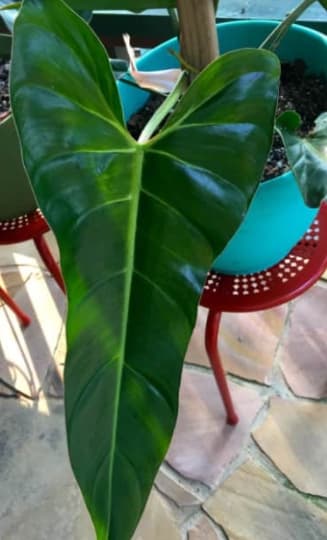
Their leaf petiole is also greenish in color which includes a little amount of chlorophyll pigment and that also assists in photosynthesis.
Stem
Their stems have pinkish hues and white streaks. I must consider that these colors have maybe provided them with extra beauty.
Well, in this case, I want to clear up the confusion. You may consider the leaf petiole that is attached to the elongated leaf surface as the stem. But that is completely wrong.
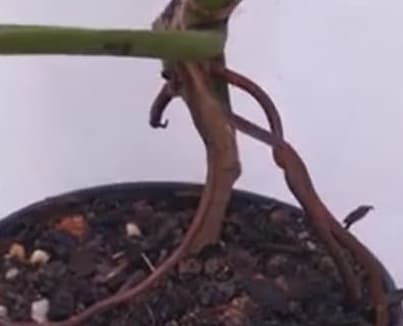
The actual stem is that in which all the leaves are arranged systematically. A small size philodendron Bernardopazii stem may not be seen because of its leaves’ arrangement around the stem.
To be crystal clear, find the place where the leaf is attached and in that sphere, you will get a moderately strong and straight formation. This is the actual stem.
Philodendron Bernardopazii is a climbing plant. If you provide proper support, it may form a beautiful shape. So, make sure to create a supportive route for their climbing.
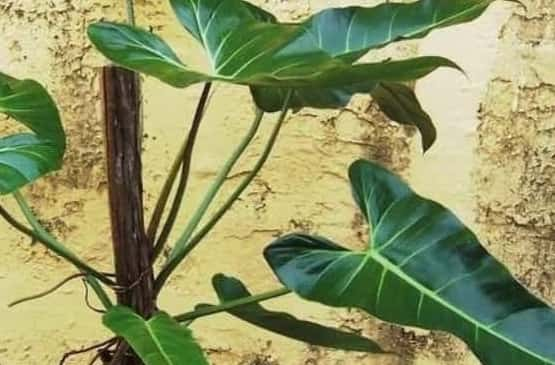
Blooming
If you find your Philodendron Bernardopazii is blooming indoors, you are really a lucky person.
I am saying this because of its rare blooming. Philodendron Bernardopazii normally blooms in natural habitats. You have known earlier that this plant is originated from the jungles of Brazil and that is the proper place for their blooming.
But sometimes in some rare conditions, it also blooms in house conditions.
Flower
Philodendron Bernardopazii has a beautiful white-colored flower. It is an outstanding showy flower.
Its inflorescences are called a spathe. The spathe is a light green inflorescence with beautiful red spots. The spadix is white green where the flowers are arranged.
A beautiful white touch can gift you a beautiful morning.
Growth rate
The growth rate of philodendron Bernardopazii is appreciable. But it needs proper conditions and materials for growth.
The philodendron Bernardopazii plant doesn’t require much attention or care. You can easily continue its maintenance on your busy days. Just the factor is you have to be concerned about its current water condition.
Proper care can make your plant grow faster. With the help of any support, it will form a beautiful shape to decorate your room.
Then, let’s check about the caring conditions of philodendron Bernardopazii.
Philodendron Bernardopazii Care (Step by Step)
We already have gained some basic knowledge about Philodendron Bernardopazii. Now we will go deeper. The steps we follow are given below-
Perfect Lighting Condition for Philodendron Bernardopazii
Let’s talk about the lighting condition required for philodendron Bernardopazii.
Philodendron Bernardopazii is a kind of plant which loves indirect but bright sunlight. Though this plant can tolerate any kind of light, it should be placed near the window where they don’t receive any kind of direct sunlight.
If you are a plant lover, a nice idea for getting indirect bright light for your plant is to add a white curtain in the window and put your Bernardopazii there.
Electrical light maybe a little help for them. But this is not an important or mentionable source.
Conditions happening in direct sunlight
Have you found your philodendron Bernardopazii leaves yellowing or lightening in color? This may have happened because of direct sunlight.
Also sometimes the leaves may burn because of too much direct bright sunlight. In old leaves, leaf lightening may be normal but if you notice that multiple leaves, especially the young leaves are getting yellow, you can be sure of the problem of too much direct sunlight.
Solution:
Keep the plant in a place where it can get early morning or late afternoon sunlight. This sunlight is not direct and can provide proper warmth and temperature for plant growth.
Late morning sunlight and early afternoon sunlight are harmful to philodendron Bernardopazii. At that time, the direct UV ray falls on the leaf surface and on the whole plant that is absorbed by the plant and it harms the plant system.
Term of less sunlight
Getting a lower amount of light is also a hazard for Bernardopazii plants. Because of this, they will become leggy in growth. Again new growth will be retarted or new leaves may be smaller than the regular growth of your lovely philodendron Bernardopazii.
Solution
If you want to get a healthy Bernardopazii, keep your pot in some type of spot where they get indirect bright light.
You can use artificial growth light if you haven’t found any suitable place for getting your plant bright indirect light. Under artificial grow light their growth will be regular.
Philodendron Bernardopazii Watering
Watering is an important term if you want to have proper growth of your philodendron Bernardopazii plant. You can’t overwater or underwater this plant.
Overwatering
Overwatering Bernardopazii is a plant that needs a decent amount of water. A suitable amount of water is needed when the soil is dry enough. Philodendron Bernardopazii is such a plant that can’t survive in water-clogging conditions. The problems caused by overwatering are-
- Root rot
- Black leaves
- Pale stems
Solution
When the upper surface of the soil is dry about the depth of 2 to 3 inches, then the plant is preferred to be watered.
You can stick your finger in the soil to check whether it is moist or dry. In the area of lower temperature, they need a little amount of water.
The concern about pot size may protect your plant from these problems. A big pot can hold a lot of water and the small one is vice versa. You can use any of the two. Just keep in mind that the pot should contain a perfect drainage hole.
Underwatering
Underwatering problem is also hazardous for philodendron Bernardopazii. This plant normally doesn’t require much water. But a proper amount of water is surely needed and you have to provide it. The problems caused by underwatering are-
- Leaves drooping
- Stunted growth
- Leaves yellowing
- Brown leaves
- Curled or fragile leaves
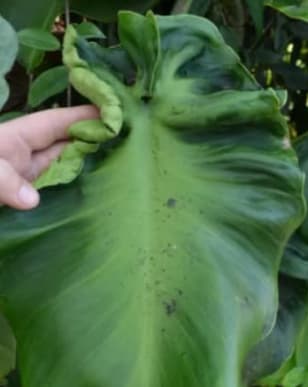
Solution
In the growing season, you should keep the soil slightly moist. In such a place where the temperature is high, they need a lot of water.
If you see the edges of the leaves are starting to curl or drooping then check the soil. As you know every plant loves natural rainwater. Distilled water is also fine. But if you can’t afford distilled water then use tape water but you have to make sure that the tape water is at room temperature. Coldwater will give your Bernardopazii a shock.
Aquarium water is also ok.
Philodendron Bernardopazii Soil Criteria
Normal sandy loam soil is good for philodendron Bernardopazii. Sandy loam soil’s characteristics are good for soil drainage and retaining water to the soil.
Lightweight, nutritious, permeable, well-drained soil enriched with high organic matter is the best soil for philodendron Bernardopazii.
You can use garden soil. But garden soil sometimes keeps water which is not good for your Bernardopazii. Also, they can grow in sphagnum peat moss. The best practice is to do some mixtures with the soil. Like,
- Perlite,
- Peat moss (For keeping the soil moist)
- Orchid bark
- Charcoal or Coconut Fiber (it helps to remove toxicity from your plant)
You can make this soil mixture and use it in your Bernardopazii. The main thing is the soil should be well-drained. Because the root rot problem is the result of non-well draining soil. So, you have to be concerned about this.
In terms of the pH level of the soil, the standard value should be between 6.9-7.3.
Philodendron Bernardopazii Temperature Requirement
In terms of temperature, Philodendron Bernardopazii is gentle. This plant needs a normal temperature for proper nourishment. Too much hot or too cold is resistant to its growth.
Optimum temperature is that in which a plant can complete its all life cycles properly. The optimum temperature of Philodendron Bernardopazii is 18 to 27 degrees Celsius or 64 to 81 degrees Fahrenheit.
High temperature
If the temperature is more than needed, it will lead to
- Burning of leaves
- Yellow leaves
- Crispy and fragile leaves
- Leaves drop off
Solution
Adjust the temperature for the betterment of the plant. In the garden, you can plant it in such a place where a shelter is already prepared to save it from excessive temperature.
If it is in the pot, keep the pot in a humid place where it can be saved from excess temperature.
Low temperature
If the temperature is too low, the plant will get frost attack and will become pale. It may show-
- Black leaves
- Black spots
- Black stem
Solution
You may create a greenhouse situation to save your plant from excess temperature. This plan is regulated in the cold regions for crop production. It may be applied in the gardens. Create a boundary with glasses to cover the plant. It will protect your plant from frost.
You can also go for a simple way. Pot plants can be put in a simple hot room where they can gain more temperature than natural temperature.
Philodendron Bernardopazii Humidity Criteria
Humidity is the percentage amount of water present in the air. This criterion is very important for the Philodendron Bernardopazii plant because many caring topics are dependent on it such as watering.
A humidity percentage of 60-70% is supposed to be perfect for the Philodendron Bernardopazii plant.
Problems in High humidity
Excessing nothing is preferable for any plant. The Philodendron Bernardopazii plant needs just a small portion of attention but that should be with great concern.
High humidity causes the leaves to fall off and at the same time, the leaves become pale and black.
Solution:
You can use a humidifier to check the condition of the plant. If it is more than the optimum, stop watering. It will reduce the soil humidity.
If the environmental humidity is high, try to keep your plant in a warm place.
Problems in Low humidity
Low humidity causes the leaves to become flabby. The normal strength of the leaves is totally devastated and the leaf surface loses its waxy and glassy constituents.
All of the portions of the plant droop off and lastly, the plant can also die.
Solution:
Check the humidity first and then try to adjust the absolute humidity. A sprinkle of water can increase the soil and plant humidity. Try to keep some water source near the plant in the garden.
Philodendron Bernardopazii Fertilizer
Fertilizer quality is damn important for a plant’s growth. Philodendron Bernardopazii won’t require many fertilizers but fertilizing once biweekly is important for its growth.
When it is in the growth phase, providing fertilizers regularly will make it prominent. General fertilizers can be diluted to the plant and then it is applied.
You can pour the diluted fertilizer into the soil of the plant. Otherwise, it can be sprayed in the leaves and the stem. Pouring to the soil is more appropriate because it will offer fertilizers to the root also is more important.
Deficiency of fertilizer
Fertilizer deficiency will retard the growth of the plant. The leaves and stems will no longer be elongated and they will start to become pale. The overall processes will be slow and plant growth will be a little.
Solution:
Fertilizer should be added once biweekly when the plant is in a growing stage. It should be done with care so that excess fertilizer is not poured. The proper amount of fertilizer is appropriate.
Over fertilizer
Fertilizing over may make your plant die. Besides, the drooping problem is also there. Plants can’t survive if they are in excessive fertilizer. The photosynthesis and especially the respiratory system may be damaged because of over fertilizer.
Solution:
Try to apply an accurate amount of fertilizer and it should be diluted in water. If excess fertilizer is sprayed, you should wash it with a strong stream of water with a pipe or tap.
Philodendron Bernardopazii Propagation
Philodendron Bernardopazii propagation system is one of the easiest propagation systems. You can easily multiply your plants by following a few steps.
Philodendron Bernardopazii Propagation is normally done by using vegetative propagation. It blooms rarely. So finding seeds is almost impossible. In this respect, two steps are easily done.
- Stem cutting
- Air layering
So let’s have some ideas about these processes.
Stem cutting
1. Preparing soil
Garden soil may be good for the Philodendron Bernardopazii plant. But if you mix some fertilizers or some nutritional substances, it will be more fertile.
2. Cut the stem
Firstly, take a sharp knife and cut a portion is stem with nodes,
3. Pot planting
Put the cut part in the rooting hormone and after that plant it in the prepared soil. Let them allow and to grow sometimes.
Air layering
Air layering is the process where propagation is done though the propagating material is attached to the mother plant.
Step 1:Making wound
This wound is not any severe one. Make a little deep cut to the stem. The plant system should not be injured.
Step 2: Placing hormones
Rooting hormones should be placed in that place. Sphagnum moss layer is also added in the cut.
Step 3: Wrapping
Wrap the wound with polythene.
Step 4: Growth of plant
When new plant roots come out, take the seedling and plant it in a pot.
The stem cutting method is more suitable in this case.
Repotting of Philodendron Bernardopazii
Repotting refers to planting a Philodendron Bernardopazii in a new pot from the oldest one. You can go for repotting due for two purposes.
- Root rot
- Rootbound
Well, allow me to describe the details.
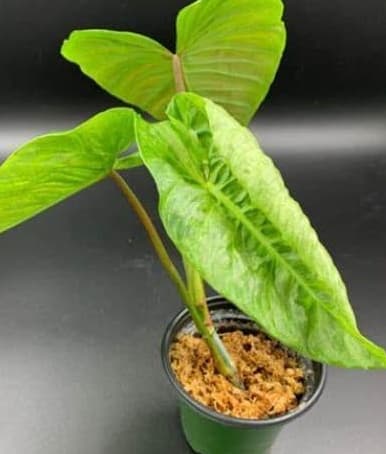
Root rot
Root rot problem occurs when the plant is overwatered. The excess water is clogged in the surroundings of the root.
Sometimes, if the drainage procedure is not well developed, the upper surface of the soil remains dry but lower portions remain wet. In that case, if you water the plant, the root will be submerged into more water than it needed which will cause root rot and is harmful to the whole plant system.
In this case of root rot, you have only one solution and that is repotting. If the maximum portions of the roots are damaged, don’t worry.
- Just take a new pot.
- Prepare soil mixture with soil, peat moss and fertilizers.
- Pull out the affected plant and plant it on the new pot.
Your problem is solved.
Rootbound
The rootbound problem happens when the plant grows larger in size. With proper maintenance and fertilizers, the Philodendron Bernardopazii plant can grow faster. In that case, the pot you have used for the small plant will be congested and the growth system of the root will be retarted.
The whole plant system will be suffocated if the plant can not grow its roots proprly. For this purpose, we need to plant it again in a new pot. This is called repotting. This is to just support the plant for its improvement.
Common Pests Attack
Aphid and spider mite
Aphid and spider mite is the most common microorganism for Philodendron Bernardopazii. They affect the plant and try to burn the leaves which include black spots on the leaves. Normally their first attack happens on the leaves.
Solution:
Firstly, you can wash the affected parts by the strong stream.
A handmade solution is enough for these pests. 4 teaspoons of baking soda in 1 gallon of water can make the best homemade solution. Spray it on the plant. It will be saved from the diseases.
Fungi
Fungal disease is another common problem of Philodendron Bernardopazii. Fungas may attack the leaves or stems of the plant. Fungus normally complete their regeneration process in the cell sap and multiply their number very fast.
Leaf burn is the main indication of fungal growth. It creates a root-knot problem that hampers all the processes of the plant body.
Solution:
Baking soda is the best solution for fungal growth. You can also use neem oil as another good solution.
Sometimes industrial fungicides like nissodium, copper fungicide etc. are also used to prevent the fungus.
Price
Philodendron Bernardopazii is a rare plant. So it may cost a little more than other houseplants or other philodendron plants.
A small plant of two younger leaves may cost almost $35 to $75. But you have to be careful about selecting your plant.
Where can I get philodendron Bernardopazii?
You can have a Philodendron Bernardopazii plant online. Getting these in nurseries may be troublesome for you. As it is a rare plant, it may not be in the collection of all nurseries.
But you can easily order it through any gardening page. But make sure that the source is authentic which can provide you with the perfect Philodendron Bernardopazii plant.
Final thoughts
Philodendron Bernardopazii is really a lovely plant. You can not avoid its superiority. Its glance will adorn you with overwhelming feelings. But you should also provide perfect caring.
The caring should be least but it has to be perfect. Only this condition will give Philodendron Bernardopazii plant a superior look.
A busy day but just a look at the plant can make your whole day stress free. If you want to remove such boredom, you must select the Philodendron Bernardopazii plant to decorate your house or garden.
FAQs
1. What is the best way to decorate with philodendron Bernardopazii?
Placing a Philodendron Bernardopazii plant in a pot corner of the room can decorate your house in the best way. The enlarged leaves will fill up a moderate amount of place.
Again, the pinkish petiole and stem will give multiple colors to your leaf. The fall of sunlight or any other light will make them glitter which will be reflected in your room.
2. Is Philodendron Bernardopazii toxic?
The philodendron Bernardopazii plant may show toxicity to someone. It contains calcium oxalate. It creates irritating situations like itching. It may also be toxic to the pets.
Direct continuous attachment to the plant may cause skin sensitivity. Applying fertilizer or water or other things without direct contact may be more appropriate.


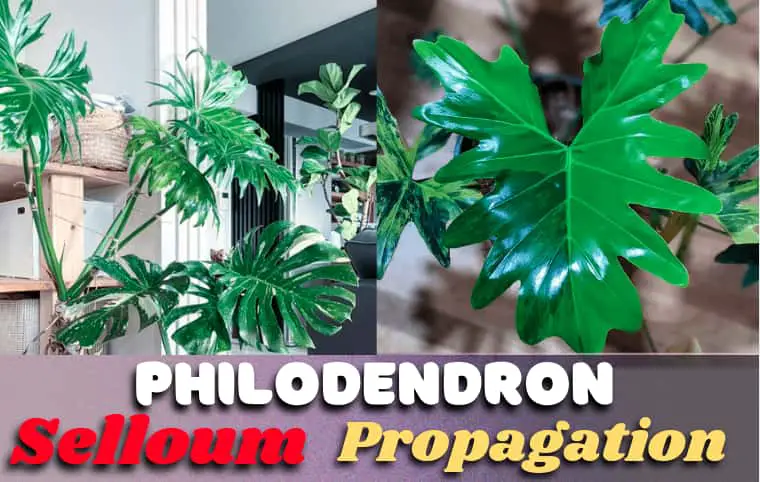
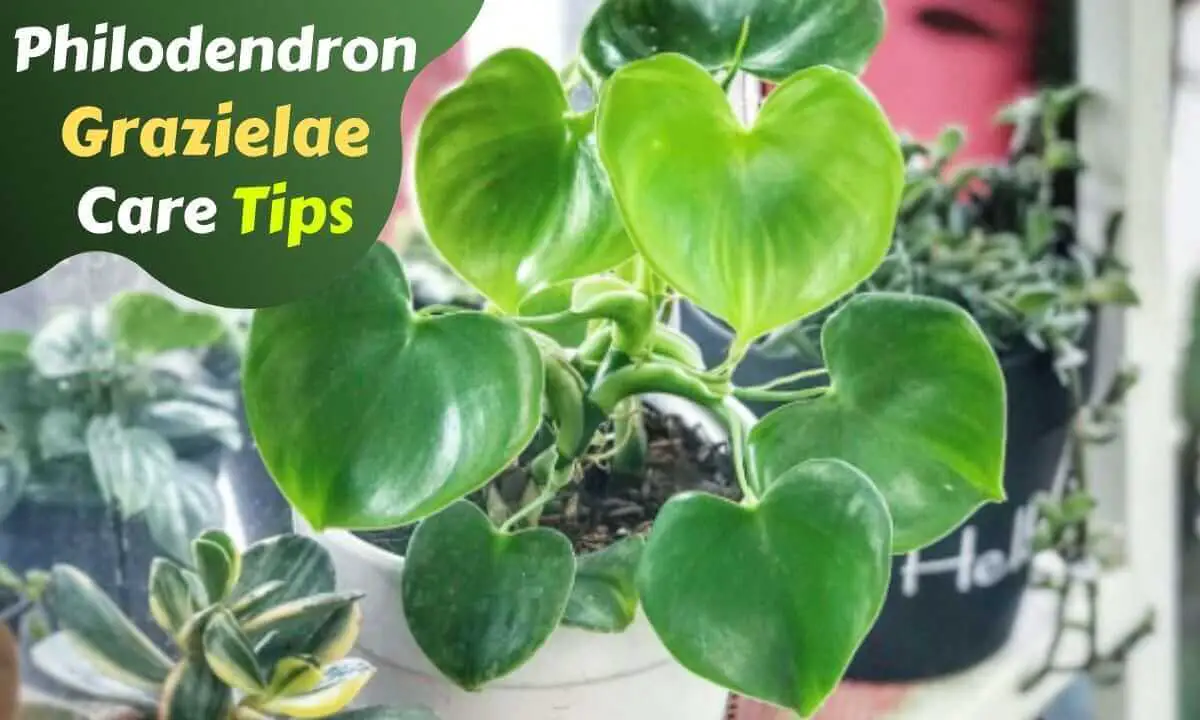
![Snake plant watering schedule – [Quantity, Time, Interval]](https://diaryforgardening.com/wp-content/uploads/2022/02/Snake-Plant-Watering.jpg)

